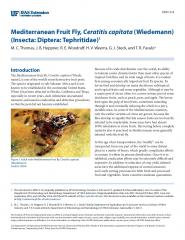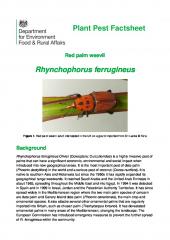Palmyra Palm, Borassus flaballifer, is a very tall, dioecious, single-stemmed evergreen palm tree up to 30 m high. The crown is composed of approximately 60 large, fan-shaped leaves. It is found in East Asia where it is highly valued for its various uses. The mature fruits are consumed raw or cooked while the immature ones are pickled. The inflorescence produces a sugar-rich sap that can be drunk or made into a sweet syrup or solid palm sugar . The seed, inflorescence, and apical bud are edible as well. Sprouted seedlings of Palmyra palm can also be eaten raw, cooked, or sun-dried for later consumption. Salt can be made from the leaves. Further, Palmyra palm has many traditional medicinal uses. One of which is its anthelmintic and diuretic young roots. Heartburn and enlarged spleen and liver can be treated using the ash of the flower. Sap from the flower stalk is tonic, diuretic, stimulant, laxative, amoebicide, and anti-phlegmatic among others. The fruits, leaves, and base of petioles are sources of different fibres. The leaves are used in thatching and as fuel. The wood is used as construction material and fuel and it can be made into charcoal.
Other Names: Toddy Palm, Sugar Palm
Borassus flabellifer is an evergreen Tree growing to 20 m by 6 m at a medium rate.
It is hardy to zone 10. The flowers are pollinated by Bees. The plant is not self-fertile.
Suitable for: light , medium and heavy soils and can grow in nutritionally poor soil. Suitable pH: acid, neutral and basic soils and can grow in very alkaline soils.
It cannot grow in the shade. It prefers dry or moist soil and can tolerate drought.
Industrial Crop: Fiber Management: Standard Regional Crop Staple Crop: Oil Staple Crop: Sugar
The palmyra is a very adaptable palm that can succeed in a wide range of conditions in dry to moist tropical and subtropical climates. It grows best at elevations below 800 metres. It can survive with as little as 250mm of rain a year, and one month or more where rainfall is below 25mm, cropping satisfactorily with 500 - 900mm per year. It will also grow and crop well with rainfall as high as 5,000mm per year. It grows best where temperatures never fall below 10°c, with an optimum mean annual temperature around 30°c, but it withstands extreme temperatures as high as 45°c and as low as 0°c. Plants grow well in full sun, even when small. Prefers a sandy soil, but plants are able to succeed under a wide range of conditions. Established plants are quite drought resistant and also survive waterlogging quite well. The palm starts flowering and fruiting 12 - 20 years after germination, usually in the dry season. A dioecious species, both male and female forms need to be grown if fruit and seed are required. Suitable for xeriscaping.
HabitatsDry
Habitatsmonsoonal areas in both forested and open country
Habitatsoften forming large stands.
Resources
IN37100

EENY-214
Mediterranean Fruit Fly, Ceratitis capitata (Wiedemann)
(Insecta: Diptera: Tephritidae) 1https://edis.ifas.ufl.edu/pdffiles/IN/IN37100.pdfIN37100IN37100
EENY-214
EDIS - Electronic Data Information Source - UF/IFAS Extension
Mediterranean Fruit Fly, Ceratitis capitata (Wiedemann)
(Insecta: Diptera: Tephritidae) 1Rhynchophorus ferrugineus Defra PP Factsheet Oct 2016 FINAL4

Red palm weevil
Rhynchophorus ferrugineus
Figure 1. Red palm weevil adult intercepted in the UK on a gourd imported from Sri Lanka © Fera
Background
https://planthealthportal.defra.gov.uk/assets/factsheets/Rhynchophorus-ferrugin…Rhynchophorus ferrugineus Defra PP Factsheet Oct 2016 FINAL4Rhynchophorus ferrugineus Defra PP Factsheet Oct 2016 FINAL4
Red palm weevil
UK Plant Health Information Portal
Rhynchophorus ferrugineus
Figure 1. Red palm weevil adult intercepted in the UK on a gourd imported from Sri Lanka © Fera
Background
